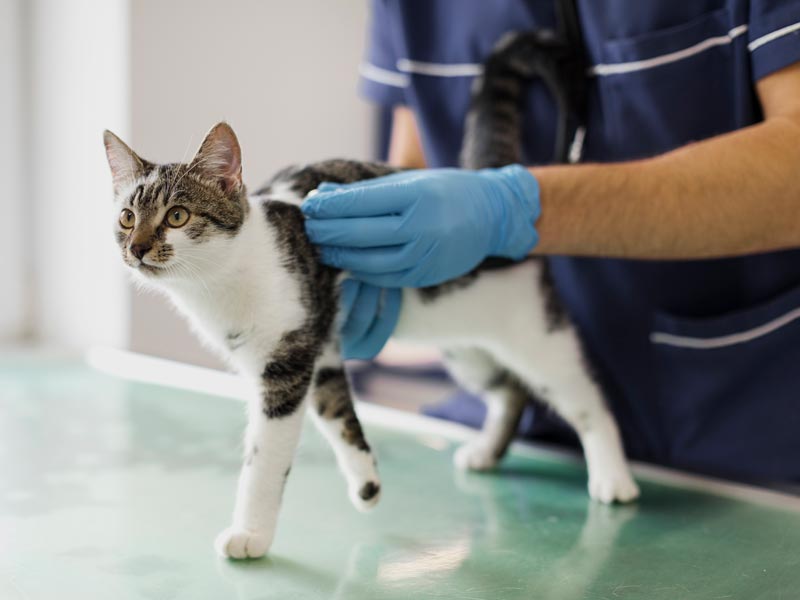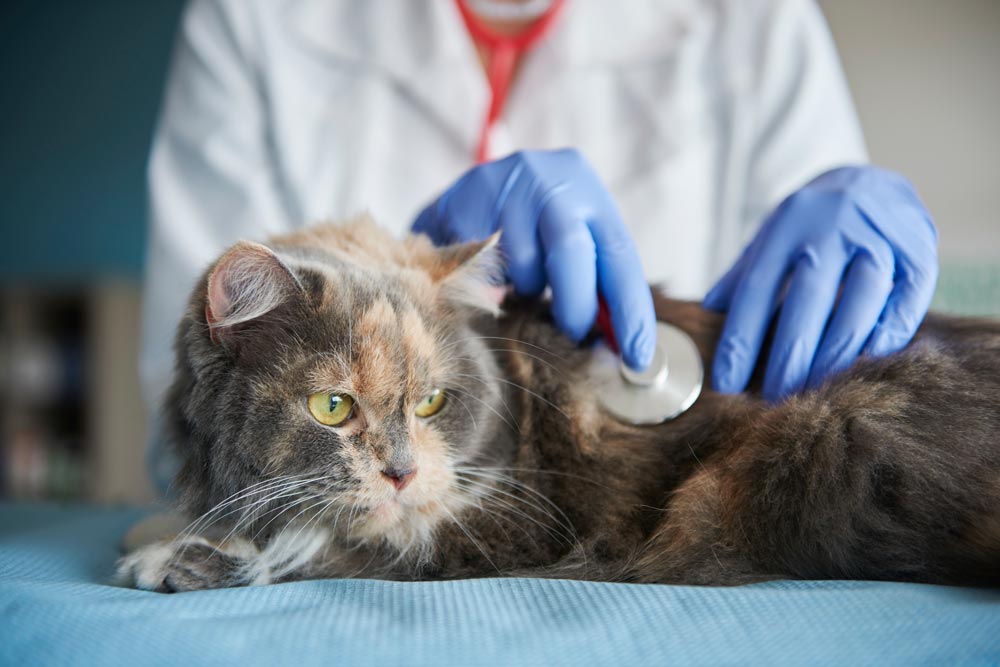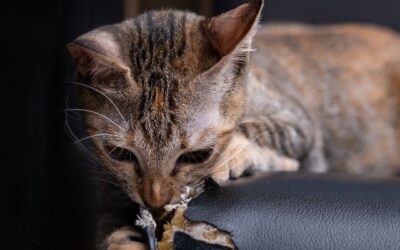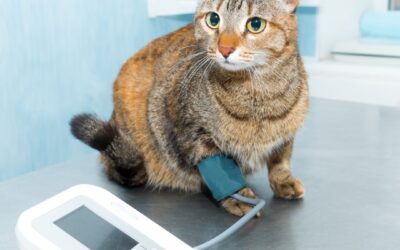Cats can develop a number of dangerous diseases like any other living being. Some of these are deadlier than the rest. You may not realize that your cat is sick just by looking at her. However, remember that sick cats will mostly have lower energy levels. They will sleep more than they usually do, play less, eat and drink less, and appear restless. Monitor cats on day to day basis, and if your cat’s activities are unusual, those are your cues to get her checked to rule out the most dangerous cat diseases listed below. In case you suspect any sign of illness, visit a vet without further ado.

Regular visits to the vet can help with the early diagnosis of dangerous cat diseases
Here are some of the most dangerous cat diseases known to feline kind
Feline Leukemia Virus (FeLV)
Feline leukemia (FeLV) is not a form of cancer, but it can cause cancer. In the United States, FeLV is present in 2-3% of the cat population, but it spreads at a drastic rate. Thus it cannot be taken lightly. While it is true that FeLV is a serious health concern, it does not lead to direct death. According to Bestfriends, if diagnosed as an adult, some cats can live up to 15 years.
Causes: Cat leukemia is highly contagious. It can spread easily from one cat to the other through nasal secretion, feces, saliva, urine, and the milk of an infected cat. Kittens can get it through their infected mothers. Healthy cats can contract the virus from the infected ones due to social behaviors such as sharing food and litter boxes or, biting and grooming each other.
Risk factors: Age (Kittens), gender (Male adult cats), and living in a multi-cat household.
Symptoms: Some common signs include lethargy, anemia, fever, weight loss, gait issues, swollen lymph nodes, recurrent infections, persistent diarrhea, poor coat condition, and inflammation of mouth tissues. Lymphoma and Fibrosarcomas are conditions associated with FeLV.
What if ignored: FeLV is responsible for many cat deaths every year globally. It’s a virus that can cause cancer in cats and gradually shorten their lives. If you notice any symptoms of FeLV, rush to a veterinarian for appropriate diagnosis and treatment.
Prevention: There is no cure for FeLV. Most cats have to accept a shortened life post-diagnosis. But the good news is that FeLV is preventable. In a multi-cat household, if one of the cats is diagnosed with FeLV, she should be kept away from other healthy cats to avoid transmission in any way. Post diagnosis, the infected cat should be strictly kept indoors. You can check with your veterinarian to include FeLV vaccination in their health plan. However, if the cat or kitten is already infected, then the vaccination is of no help. Thus, you should get your cat checked regularly and keep an eye out for symptoms if any.
Diabetes
According to Cornell University, in the general population, 0.2 – 1% of cats are believed to suffer from diabetes. That’s an alarming number. It occurs when the body can no longer produce or use insulin properly. Diabetic cats mostly have the Type II form of the disease. Diabetes in cats is treatable. If diagnosed and treated early, cats can have an average life expectancy.
Causes: A cat’s body also needs sugar in the form of glucose for energy. If a cat suffers from Diabetes Mellitus, her body is either incapable of properly producing hormone insulin or responding to it. A decrease in insulin production leads to a higher concentration of glucose and results in Type I diabetes. If the cells in the cat’s body do not respond appropriately to insulin, the cat might suffer from Type II diabetes, which is also the most common type of diabetes in cats.
Risk factors: Age, sedentary lifestyle, obesity, gender – male, glucocorticoid therapy, Burmese breed
Clinical signs: Weight loss and excessive thirst and urination
- Weight loss – The cells’ inability to absorb glucose from the blood makes the cat starved of energy. When the body turns to other energy sources, it breaks down fats and proteins, increasing appetite and leading to weight loss.
- Excessive thirst and urination – The body excretes excessive amounts of glucose in the urine. High urine glucose concentration leads to increased urine volume, dehydration, and an increase in thirst.
What if ignored: Uncontrolled diabetes in a cat can damage the nerves in their hind limbs. It gradually leads to undernourishment, diabetic acidosis, and death.
Prevention: Your cat’s diet plan should include a high protein–low carbohydrate–moderate fat food. To plan this correctly, you should be aware of the ingredients in the dry and wet food you give your cat. Read this article to learn how to read the ingredient’s label on cat food packets.
Feline Immunodeficiency Virus (FIV)
Feline immunodeficiency virus (FIV) is transmitted only from cats to cats. It cannot transfer from cats to humans. FIV is referred to as Cat AIDS or HIV because it causes similar health concerns in cats. It is one of the most common infectious diseases that attacks a cat’s immune system and damages its cells, leaving the cat susceptible to other infections. Cats infected with FIV may for five years from diagnosis, depending on the intensity of the infection.
Causes: Aggressive bite injuries from an infected cat may cause the virus to transmit to healthy cats. A kitten may get the virus from an infected mother, especially if the mother has contracted the disease during pregnancy. However, a normal sharing of food plates and water bowls or harmless grooming sessions are not known to cause the spread of the virus. Even sexual contact does not spread the infection in cats.
Risk factors: Sick cats, un-neutered stray male cats who tend to get into fights
Symptoms: In an infected cat, you may not see any symptoms for years. But it leads to several health concerns once the symptoms start developing. Common signs include fever, anemia, diarrhea, poor appetite leading to weight loss, swollen lymph nodes, dental disease, sneezing, nose and eye discharge, renal issues such as frequent urination or urinating outside the litter box, poor coat, conjunctivitis (eye inflammation), gingivitis (gums inflammation), stomatitis (mouth inflammation). If you notice a shift in your cat’s behavior, contact your veterinarian immediately.
What if ignored: The virus weakens the immune system and leads to several deadly infections.
Prevention: The sure shot way of preventing the spread is to avoid exposure to the virus by keeping cats indoors or discouraging them from getting into outdoor fights. Ensure that only infection-free cats are introduced to uninfected cats.
Remember that if a cat is purring, it doesn’t mean that she is free from pain. Badly hurt cats may purr to calm down.
Upper Respiratory Infections / Cat flu
Also known as Cat flu, the feline upper respiratory infection can be more severe than cold, especially in kittens and adult cats with underlying illnesses. Hence, it’s important to visit a vet if you see signs of cold or flu in your cat. Common reasons are different bacteria and viruses that attack the throat, nose, and sinuses, basically the upper airway.
Causes:
- Most common viruses: Feline viral rhinotracheitis or FVR and Feline Calicivirus (FCV). Feline calicivirus and feline herpesvirus cause 80 to 90% of all transmissible upper respiratory complications
- Most common bacteria: Bordetella bronchiseptica and Chlamydophila felis
Risk factors:
- If cats are kept in large groups, the viruses can spread easily
- Kittens
- Immunosuppressed and elderly cats
- Unvaccinated cats
- Stress can cause the outbreak
- Persians and other flat-faced breeds
Clinical signs: The symptoms of cat flu or feline respiratory infection are similar to flu and colds in people. Signs are runny nose, cough, sneezing, congestion, colored nasal discharge, drooling, changes in appetite, rapid breathing, fever, depression, rubbing eyes, ulcers, and hoarse voice. The duration and severity of these signs depend on the cat’s immune system.
What if ignored: An infected cat can be a carrier of the infection for life and spread it quickly through sneezing, coughing, or while grooming or sharing food and water bowls.
Prevention: If you are handling multiple cats at a time, wash your hands after every encounter to avoid any spread of disease. Lower the exposure to infected animals by keeping cats indoors as far as possible. Ensure vaccinating cats as suggested by a vet. Follow this link to learn all about cat vaccines. A healthy immune system is your cat’s best defence against any health issue, especially upper respiratory illnesses. Here is an article to help you with some best practices to ensure a decent immunity in cats to help them fight their battle.
Cancer
One reason to ensure regular vet visits is to rule out any cancer in cats. Sadly, the prevalence of cancer in cats is increasing, with 1 in 5 cats getting cancer. The common types of cancers in cats are squamous cell carcinoma, mast cell tumor, lymphoma, and bone cancer.
While cancer diagnosis in cats can be devastating for us, early diagnosis is vital to get your furry friend out of danger. Cat cancer symptoms are subtle. Knowing how good cats are at hiding pain or discomfort, how do you know that your cat has a tumor? Benign tumors stay in the tissue where they started – not cancerous, while malignant tumors are cancerous and spread within the body.
Here is some information to help you.
Causes: Unknown
Risk factors: Feline Leukemia Virus (vaccine available), toxins from the environment, passive smoking, excessive grooming, or licking parts of the body that have been in contact with an environmental toxin.
Clinical signs:
- Lumps and bumps visible externally
- Loss of appetite
- Vomiting
- Diarrhea for gastrointestinal lymphoma
- Difficulty in breathing indicating lung cancer
- Disturbed bathroom chores
- Sores that don’t heal
- Bleeding without a clear cause
- Fatigue
- Foul odor
Remember that if your cat is purring, it doesn’t mean that she is free from pain. Badly hurt cats may purr to calm down.
What if ignored: Cancer accounts for approximately 32% of deaths in cats over ten years old. Early diagnosis is imperative.
Prevention: Spay and neuter your cat at the right age. In females, it helps reduce the risk of mammary or breast cancer. Ensure a high-quality diet including fatty acids such as EPA and DHA to boost your cat’s immunity. Use household chemicals, pesticides, and other known cancer-causing agents with caution. Secondhand smoke can affect your cat’s lungs.
Chronic Kidney Disease (CKD)
Hormone development, blood pressure management, bone marrow, and waste removal from blood – cats’ kidneys have a lot to do! The fact that a cat’s kidneys perform multiple functions, it’s even more important to rule out any litter concerns in cats. There are two types of kidney failures: acute and chronic kidney failure. CKD is one of the most common and most dangerous cat diseases in full-grown cats but is not unusual in kittens either. Acute renal failure can often be reversed if diagnosed early. But chronic kidney problems can be challenging to cure.
Causes: Poisons in terms of antifreeze, human medications, and toxic plants. Trauma or burst bladder, rapid dehydration, losing a lot of blood, rise in activity, vomiting, diarrhea, kidney infections, urethral blockages, low blood pressure.
NOTE: A single tablet of ibuprofen can shut down a cats’ kidneys.
Risk factors: Age. Approx. 30% to 50% of cats older than 15 years of age have CKD. Male cats are prone to the disease at a younger age. Abyssinian, Burmese, Maine Coon, Siamese, and Russian blue are at a higher risk of developing CKD
Clinical Signs: Early signs of kidney disease in cats may include a sudden change in the amount of water consumption, frequent urination, bacterial infections in the kidney and bladder, bad breath, weight loss, fatigue, constipation, bloody or cloudy urine (bladder concerns), vomiting, diarrhea, brownish-colored tongue, mouth ulcers, dry coat, etc.
What if ignored: Other health conditions such as Amyloidosis, Feline infectious peritonitis, Glomerulonephritis, Polycystic kidney disease, permanent loss of nephrons, etc., can develop.
Prevention: Ensuring your cat gets a natural, moisture-rich, and easily digestible diet. Encourage regular water consumption and provide your cat with a decent blend of wet and dry food. Watch out for changes in litter behavior.
While there is no guarantee, being proactive about your feline’s health can help prevent some of these dangerous cat diseases. We also recommend keeping some medical supplies at home in case you need to administer first-aid. Proper vaccinations, regular vet visits, nutritious food, good hygiene habits can prevent any illness in your cats and enable them to live a happier life.





0 Comments
Trackbacks/Pingbacks